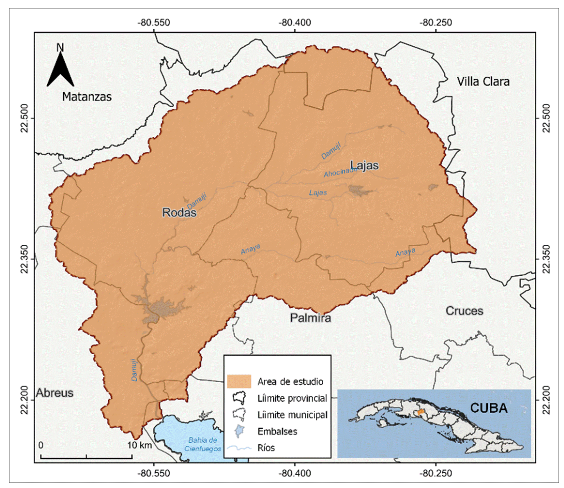Climatic characterization of the Damují Hydrographic basin
Main Article Content
Abstract
The hydrographic basins play an important role in the supply of water for the agricultural sector, as well as for other economic, social, and environmental activities in the provincial territory. Climate knowledge is of great importance for the sustainable development of any study area, so the objective of this research is to characterize climatically the area of the Damují Hydrographic Basin. For the realization of this study, the preliminary results of the Agroclimatic Atlas of the Cienfuegos province were used, the digital database of all meteorological variables from 62 meteorological stations belonging to the Meteorology Institute network and the 4x4 km grid used in other climatic and agrometeorological studies, taking as the climatic norm period the years 1991-2020. The annual average temperature in the basin does not experience a great spatial variation with values between 24-25ºC in most of its surface, slightly increasing in the southern portion with records between 25-26ºC. Minimum temperatures in the months of December, January, and February can be below 16ºC on average and maximums can exceed 31.0 ºC on average annually in the northern half of the study area, however, in the months of July and August these can exceed 33.5ºC on average. The annual average precipitation accumulations reach a total of 1422.1 mm. The generated information constitutes a tool for decision makers that will allow them to adapt and face the climate change and variability with greater knowledge.
Downloads
Article Details

This work is licensed under a Creative Commons Attribution-NonCommercial 4.0 International License.
Those authors who have publications with this journal accept the following terms of the License Attribution-NonCommercial 4.0 International (CC BY-NC 4.0):
You are free to:
- Share — copy and redistribute the material in any medium or format
- Adapt — remix, transform, and build upon the material
The licensor cannot revoke these freedoms as long as you follow the license terms.
Under the following terms:
- Attribution — You must give appropriate credit, provide a link to the license, and indicate if changes were made. You may do so in any reasonable manner, but not in any way that suggests the licensor endorses you or your use.
- NonCommercial — You may not use the material for commercial purposes.
- No additional restrictions — You may not apply legal terms or technological measures that legally restrict others from doing anything the license permits.
The journal is not responsible for the opinions and concepts expressed in the works, they are the sole responsibility of the authors. The Editor, with the assistance of the Editorial Committee, reserves the right to suggest or request advisable or necessary modifications. They are accepted to publish original scientific papers, research results of interest that have not been published or sent to another journal for the same purpose.
The mention of trademarks of equipment, instruments or specific materials is for identification purposes, and there is no promotional commitment in relation to them, neither by the authors nor by the publisher.
References
Barros, V., Grimm, A., Robertson, A., y Núñez, M. (2006). Caracterización del clima de la cuenca del Plata. REGA, 3(2), 13-28. https://abrh.s3.sa-east-1.amazonaws.com/Sumarios/68/20ca6544e21e762b25d7580800c301e1_24ade57b0049b2c3a860ee1f9eff4d3c.pdf
Carbone, M. E., Píccolo, M. C., y Perillo, G. M. (2003). Caracterización climática de la cuenca del Arroyo Claromecó, Argentina. Papeles de Geografía, Universidad de Murcia, Murcia, España, 38, 41-60.
Edwards, D. C., & McKee, T. B. (1997). Characteristics of 20th century drought in the United States at multiple time scales. Climatology Report, Departamento de Ciencia Atmosférica, Universidad del Estado de Colorado, Fort Collins, Colorado., 97(2).
González, C. (1999). Climatología de los frentes fríos que han afectado a Cuba desde 1919-1917 hasta 1996-1997. Revista Cubana de Meteorología, 6(1), 11-14
Hernández, D., y Fernández, E. (2016). Análisis de la variabilidad climática en cuencas hidrográficas de Cuba: Caso de estudio en la cuenca del río Cauto. Revista de Ciencias de la Tierra, 20(1), 30-42.
Jansá, (1974)
Kottek, M.; Grieser, J.; Beck, C.; Rudolf, B. & Rubel, F. (2006). “World Map of the Köppen-Geiger climate classification updated. Meteorologische Zeitschrift, 15(3): 259–263, ISSN: 0941-2948, DOI: http://dx.doi.org/10.1127/0941-2948/2006/0130.
Landsea, C. (2007). Frequently Asked Questions. Atlantic Oceanographic and Meteorological Laboratory, Hurricane Research Division. http://www.aoml.noaa.gov/hrd/tcfaq/tcfaqHED.html, Consultado el 27 de febrero de 2024.
Lecha, L.; Lapinel, P. y Paz, L. (1994). El clima de Cuba. La Habana, Cuba: Academia, 186 p., ISBN: 978-959-02-0006-9.
López, C., y González, R. (2019). Impacto del cambio climático en cuencas hidrográficas cubanas: Revisión de la literatura. Revista de Investigación Ambiental, 36(4), 112-125.
Lloyd-Hughes, B. & Saunders, M. A. (2002). A drought climatology for Europe. International Journal of Climatology 22: 1571–1592 pp.
Manual de Procedimiento (2000). Manual de Procedimiento, Sistema Nacional de Pronóstico. Instituto de Meteorología, CITMA, Ciudad de La Habana 2000, 63 pp.
McKee, T. B., Doesken, N. J. & Kleist, J. (1993). The relationship of drought frequency and duration to time scales. Preprints, 8th Conference on Applied Climatology, 17-22 January, Anaheim, CA, pp. 179-184.
Peel, M. C.; Finlayson, B. L. & Mcmahon, T. A. (2007). “Updated world map of the Köppen-Geiger climate classification. Hydrology and Earth System Sciences Discussions, 4(2): 439–473.
Pérez, J., y Martínez, A. (2017). Caracterización hidroclimática de cuencas en Cuba: Análisis de la cuenca del río Zaza. Revista de Recursos Hídricos, 12(3), 78-92.
Salmo, Y., Concepción, E., Zapata, L., Vinajera, V., y Rojas, Y. (2023). Caracterización climática del área de la Cuenca Hidrográfica del río San Juan. Revista Cubana de Meteorología, 29(1). http://rcm.insmet.cu/index.php/rcm/article/view/676/1379
Thom, H.C.S., (1966). Some Methods of Climatological Analysis. WMO Technical Note Number No. 81, 81 16-22.
Young, K.C. (1992). A Three-Way Model for Interpolating for Monthly Precipitation Values. Monthly Weather Review, 120, 2561-2569.

